In the fierce digital competition, businesses strive to make the most of their online presence to unlock new revenue streams and monetize their previous efforts. If you are a publisher, understanding your revenue potential and maximizing it is as important as never before.
In this article, we will dive into the core advertising monetization models so you can transform your digital presence and turn it into a monetization tool and stay ahead of the competition. Ready to elevate your income? Let’s get started!

What is an ad monetization? Definition
Before digging deeper into the topic, let’s start with the basics and cover the ad monetization meaning.
Ad monetization is the practice of taking advantage of the existing traffic you attract to your digital platform and generating revenue through placing advertisements. It implies showcasing ads to the viewers and charging advertisers for every ad impression, click, and other user engagement metric.
The growth of the mobile app market
There are hundreds of thousands of apps out there. In 2023, the number of total mobile app downloads reached 257 billion. This number is proliferating.
The mobile app market is growing exponentially. In 2024, the mobile app market is going to reach a revenue of €485 billion. By the end of 2027, this figure will grow to €629 billion.
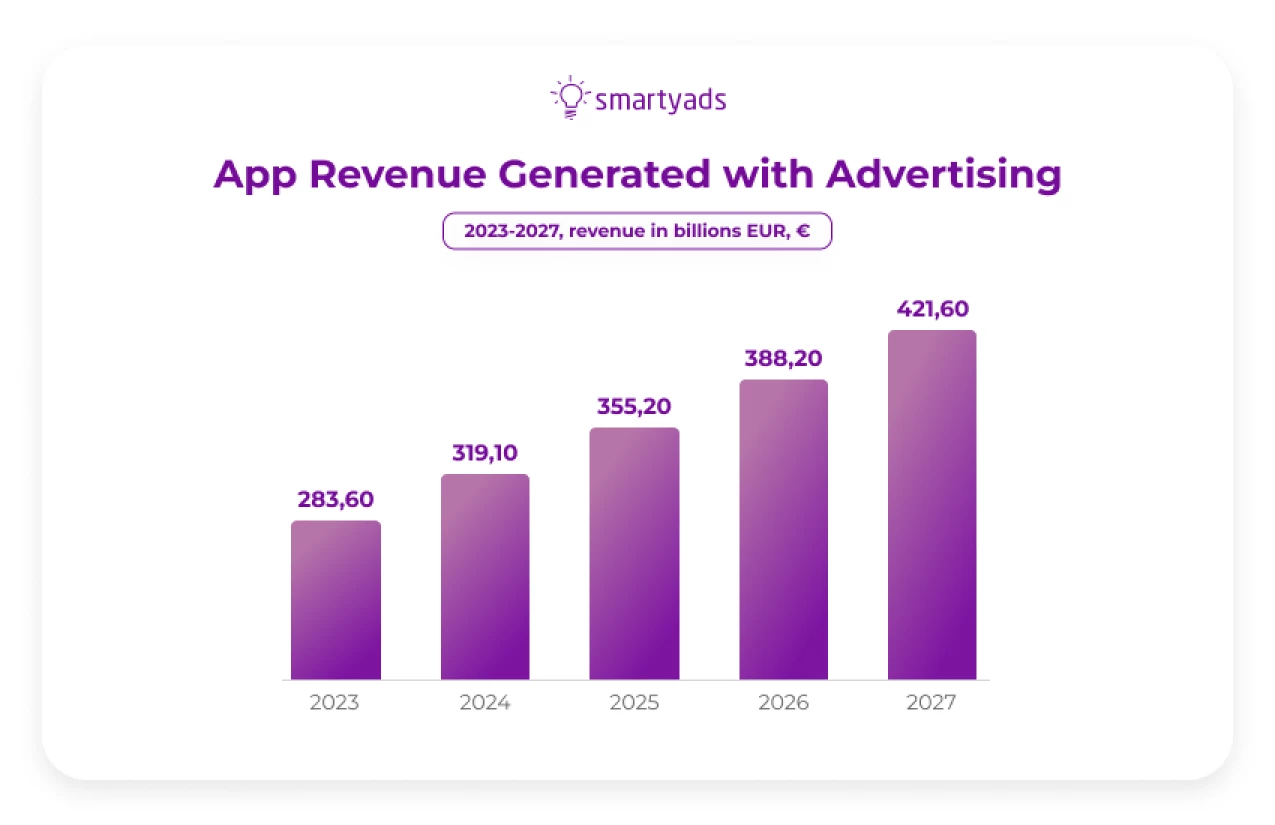
Advertising monetization: IAP, IAA, and performance campaigns
In the last few years, monetization has become a sustainable business model that helps publishers increase ad placement earnings. There are some standard models and advanced features for mobile ad monetization. If you are wondering "How do I monetize my video game, mobile game, or application?", we will inspect the well-known strategies for improving your income from selling the ad space in your app.
The most common strategies for ad monetization are:
- In-app purchase (IAP)
- In-app advertisement (IAA)
- Branding or performance campaigns
In-app purchase (IAP) is one of the most commonly used monetization strategies. The idea of this earning strategy is to make users upload a free app and then allow them to use some premium features with additional payment. Companies that use this model include Spotify (when you pay for some listening options). This model of monetization is classical for the game industry. Users can download a free game but will pay for additional resources in the premium version.
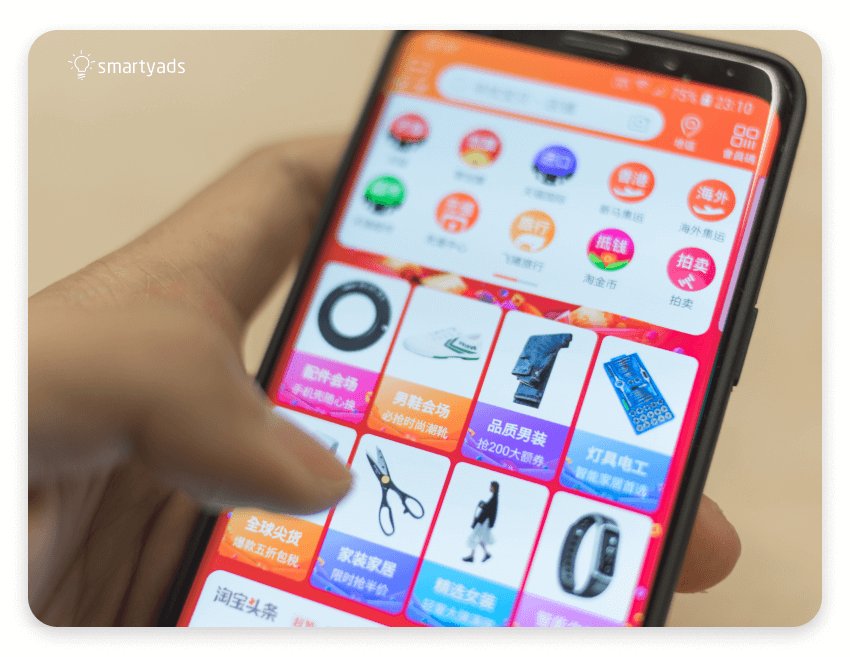
An in-app advertisement (IAA) is an ad of a third party in your app. In this model, advertisers and publishers are linked by the ad network. The most common example is the Duolingo app, where you can find a third-party ad after finishing the level.
Branding and performance campaigns also can be an efficient strategy for app monetization. Branding campaigns are usually focused on building a relationship with customers and promoting a positive image of the advertiser. At the same time, the performance campaign goal is to make users tap on the ad. The tap on the ad can trigger the installation of the application on the user’s device. Thus, you can use performance campaigns to drive more app installs.
What Are the Basic Types of Advertisement?
After defining the monetization strategy, you need to choose the ad type you want to serve in your app/on your website. There are four prevalent ad formats:
- Rewarded video;
- Interstitials;
- Offerwalls;
- Native advertising.
Rewarded video
With these ads, the user can choose to watch the video advertising and then, upon video completion, obtain free content or bonuses in exchange. With new technologies, users can also interact with the video ad (for example, answer questions) for additional premium content or bonuses. According to forecasts, 62% of gamers regularly view rewarded videos for some particular game experience. The data shows that this type of ad is the most preferable in the mobile gaming niche. At the same time, mobile game apps are not the only type of apps that use this type of advertisement. This model is familiar to Spotify, Duolingo, and others.
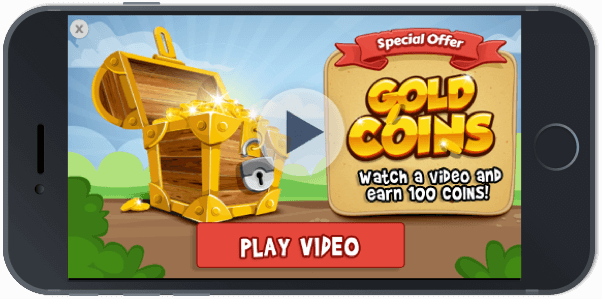
Also, there are some features in using rewarded video ads you need to pay attention to:
- Learn user experience before placing the video.
- Test the video before launching the ad.
- Segment users.
- Give your users valuable rewards.
Interstitials
Those ads are typically shown to the users while watching the app video. Those can be banners or videos (for example, they appear when users pass the level in a language learning app or during transitions between the game levels). Users can close the ad in some cases, but usually, the first few seconds will be displayed. After that, the full-screen ad with text, image, video, or rich media will appear. Interstitials ads are usually optimized for smartphones and require users to take action and interact with ads.
More interstitial ad examples can be found here.
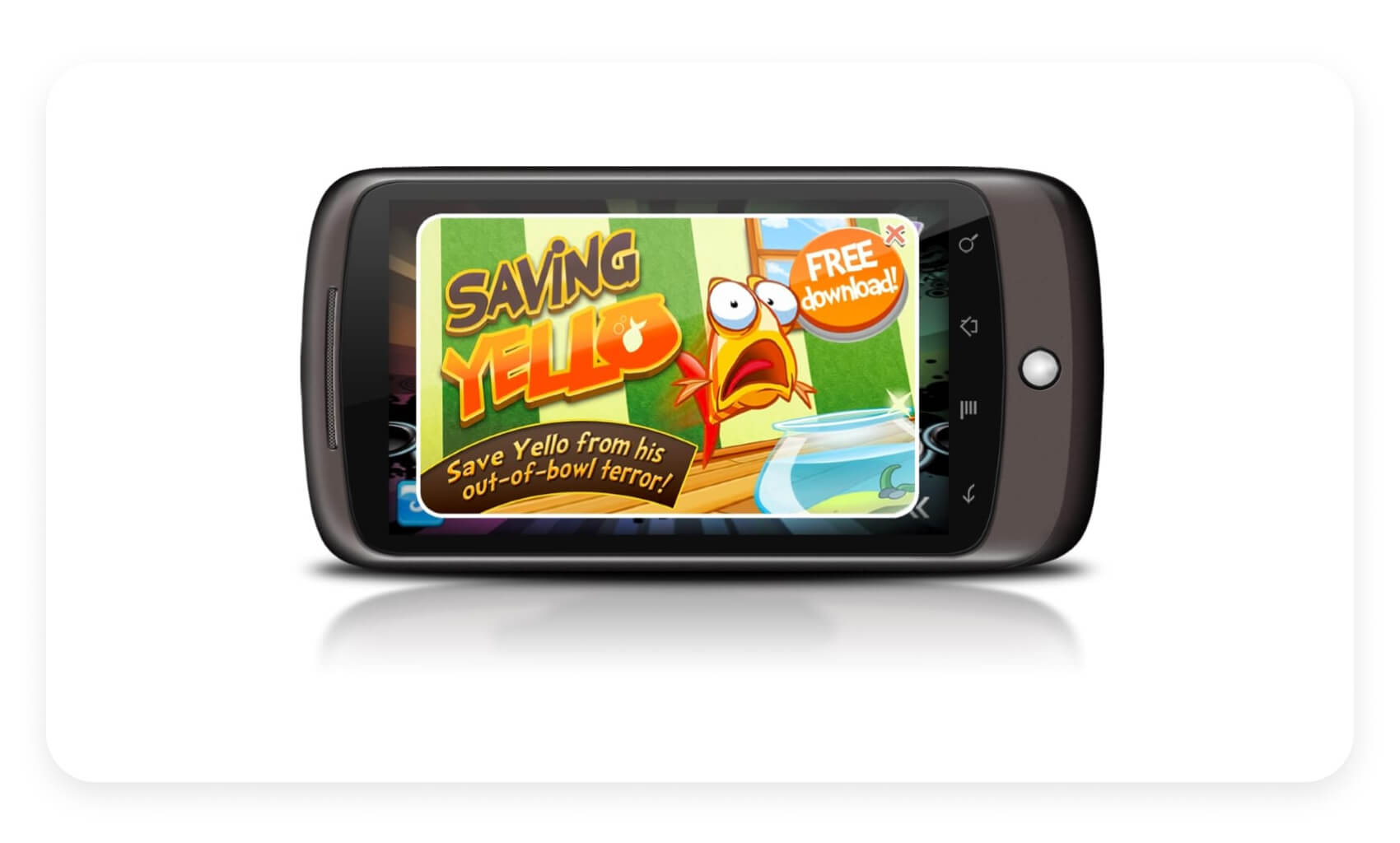
Offerwalls
This is the type of ad designed to offer special proposals in exchange for some specific user actions. For example, it can offer a subscription for the newsletter or app installation in exchange for reaching the highest level in the game. This ad allows you to increase eCPM and engage with users who already want to interact with your ad. Also, offerwalls have better user detention and provide a positive user experience.
Native ads
This type of ad usually fits the app's functions and forms and looks consistent and native. It can be a banner that looks like part of the social feed and does not affect the navigation or functionality of the app.
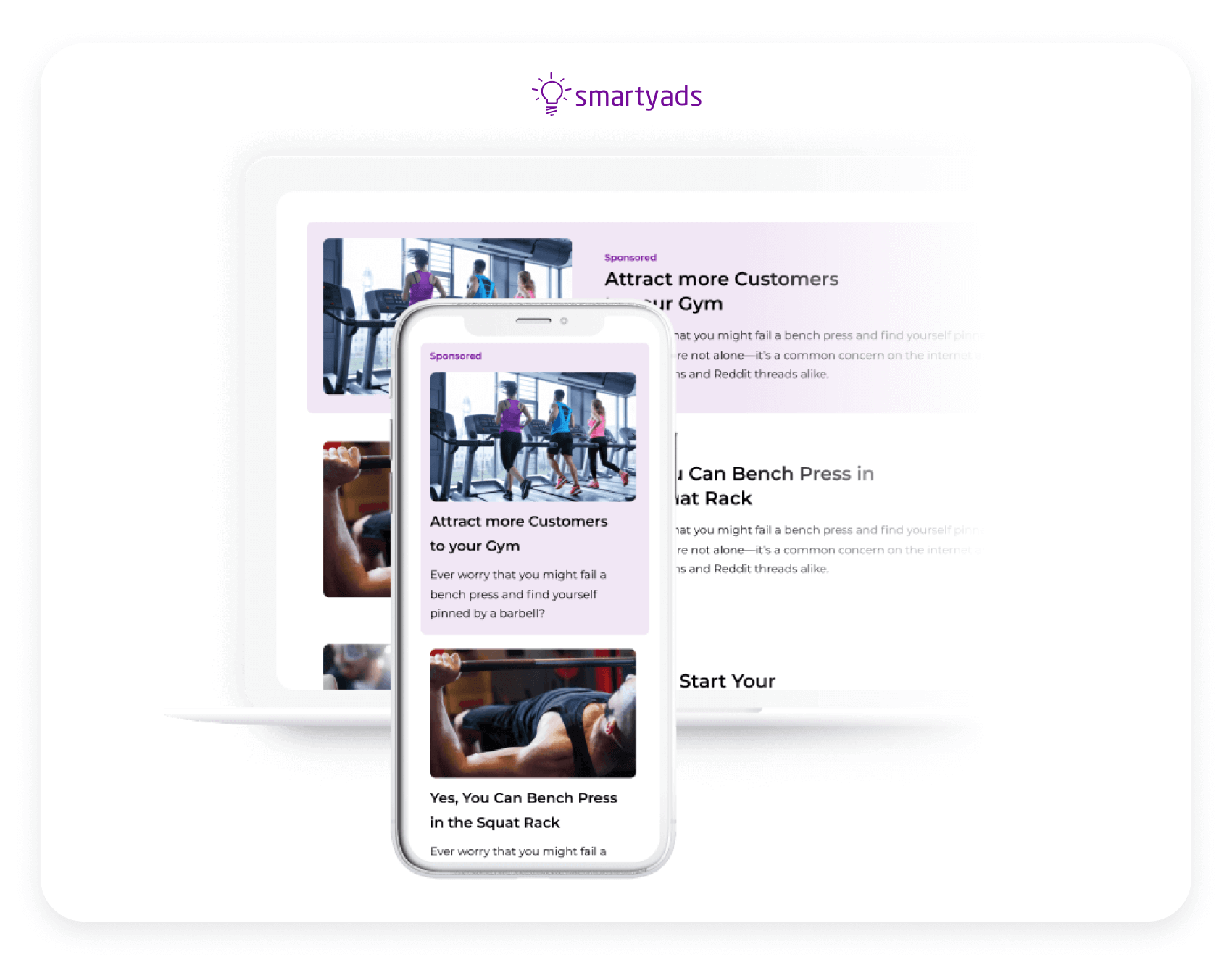
There is also much discussion on what’s better, push ads vs. native ads. Push ads usually perform better for existing customers, while native advertising helps engage with people who have not used the product/app yet. Moreover, the best way of monetization is based on the native integration of the ad with a product.

Choosing the best ad monetization strategy
In this block, we are going to guide you through the best practices and tips on how to monetize advertising effectively.
Analyze your audience
First of all, the basis of every strategy is knowing and understanding your audience. It’s a cornerstone of your success, so invest time and research to understand what people visit your website, how they interact with your content, and what their preferences, interests, and behaviors are.
Also, take into consideration their geolocation and demographics, as they will be the foundation of your further steps in generating revenue from your ad space. Various analytical tools will provide you with enough data and insights to make a well-informed decision. Remember, each step will define your monetization outcome and can lead you to higher engagement rates and earnings.
Consider different ad formats
Your research findings will help you proceed with this one. Not all ad formats will work the same for different audiences visiting your website or app. First, familiarize yourself with the main ad formats available and their advantages to see which of them you can easily enable to cover the demand of advertisers willing to buy your ad space.
Display ads are visually engaging and can bring a lot of quality results and revenue. Video ads are not the universal choice for all publishers, but since it’s highly dynamic content, they can generate substantial income. Find the formats that won’t be intrusive and will fit naturally into your platform. Strive for a balance between the revenue and user experience.
Know well CPM and CPA pricing for publishers
Two of the most commonly used ad monetization bidding models are cost per mille (CPM) and cost per action (CPA). Next, we will discuss the benefits of each bidding model for publishers.
CPM. With this type of bidding, publishers will pay for every thousand views of your ad, even if the user did not interact with it. This type of bidding usually works for branding campaigns and for ecommerce marketing campaigns. It helps to increase the level of brand awareness. If your platform has high traffic, it will be easier to monetize ads.
CPA. With this model, publishers are only paid when users click the ad or install the application from the advertisement. This model is often used for performance campaigns. With this model, the general ad strategy is essential for revenue. Publishers get money for clicking or filling the forms by users, but not for selling a product. It means that with an accurate target, you can have more user actions and, as a result, more income. We have a dedicated article on how to calculate CPA.
What is a Good eCPM?
The effective cost per mille is a standard measurement system that publishers can use to measure the effectiveness of advertising. The most common question is how to calculate the eCPM. To calculate the eCPM while running a CPA ad, you need to divide all paid CPAs by 1000. For example, if you paid $10 for every game installation, you need to divide 10/1000. You will get a $0.01 cost for every impression. With this number, you can calculate the general revenue from the running ad.
Select the right supply-side platform (SSP)
First, you need to understand what is a supply-side platform. SSP is software that helps publishers sell the ad space, provide ad optimization, and analyze ad campaigns. The SSP dashboard helps manage and configure the ad serving process. Also, it allows publishers to analyze the data and choose the best type of ad for different monetization strategies. Nowadays, SSP is a must-have for publishers that want to obtain the most valuable results from running the ad.
How SSP Works
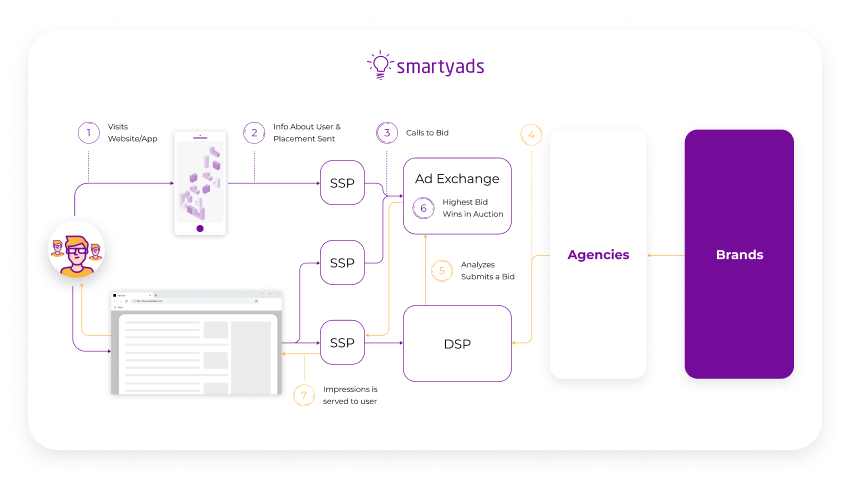
The supply-side platform is directly connected to an ad exchange, ad network, data management platform, and publisher’s website. It helps to sell ad inventory on behalf of publishers.
Ad Network vs Ad Exchange: what's better? Read here.
The number of visitors attracted to a website also influences the cost of the ad. SSP gets the information about the audience, advertisers bid from the DSP, and after the auction is held at the ad exchange, it announces the winner and sends the ad to the user. Moreover, SSP helps publishers to manage and optimize programmatic ad-selling processes.
SSP Benefits For the Publishers
Publishers want to sell as much space as is available on their platform. SSP helps to optimize the campaigns and get the highest earnings from publishing the ads.
The main benefits for publishers in using SSP:
- Selling automatization. SSP makes the selling process fully automated and excludes manual publishers' work.
- Analytics. SSP ensures publishers get a detailed analysis of the campaign and manage it in real time. You have information on impressions served and their effectiveness.
- Setting floor price. This SSP option protects the publishers from selling the inventory for a meager price.
- Working with multiple networks. SSP increases the value of impressions by connecting to numerous networks. This way, more buyers can take part in the bidding.
- Helping sellers to control campaigns. With SSP, publishers can define precise forms, sizes, and types of ads that they want to be displayed in their ad space.
- Safety. SSP will block all inappropriate ads. It is easy to create a block list for some IAB categories and protect publishers from unwanted ad content.
Comply with policies and regulations
In the digital landscape, adhering to policies and regulations is paramount. Not to undermine users’ trust and build loyal relationships with advertisers, dive into GDPR and CCPA to mitigate all the risks related to privacy violations.
Come up with a transparent and simple user consent policy offering them clear data on how their data is being used, stored, and processed.
Continuously analyze your efforts
Building a monetization strategy is a continuous process that never ends. It’s absolutely essential to regularly monitor your performance as well as the main metrics like CPM and CPA we described above. But in today’s engagement-driven ecosystem, it’s just as important to keep an eye on attention metrics — indicators like dwell time, scroll behavior, and engagement depth — to truly understand how audiences interact with your ads. Analyze your data to see where you can improve your efforts, enhance what already works well, and make sure your monetization isn’t just loud, but actually listened to.
A/B testing will be an amazing help that will enable you to test different approaches and strategies in case you are not sure which one is more suitable and effective. This way, you will be able to make data-driven decisions, optimize your inventory to maximize revenue, and satisfy the advertisers’ demands and users’ interests.
Why use SmartyAds SSP?
First of all, SmartyAds SSP provides one of the best CPM in the market. We ensure the broad network for the best demand sources with beneficial conditions of a programmatic selling model. Web users will see personalized ads that are effective and yet go along well with website/app content.
With SmartyAds, publishers can serve the best ad formats and control the price per view to increase the final income. We have one of the most progressive SSP solutions in the market that allows publishers to get the highest payments and optimize space.
Final word
By implementing these effective ad monetization solutions, you will boost your revenue and achieve your business objectives more easily. Now, you can use the understanding of these strategies to build, launch, and optimize your ad placements and create a sustainable ad monetization plan.
SmartyAds supply-side platform will help you implement the most sophisticated monetization strategies as our company has rich expertise in programmatic. If you need detailed consultation on using SmartyAds SSP, you can contact our experts.
Register on SmartyAds SSP and get started on effective ad monetization!

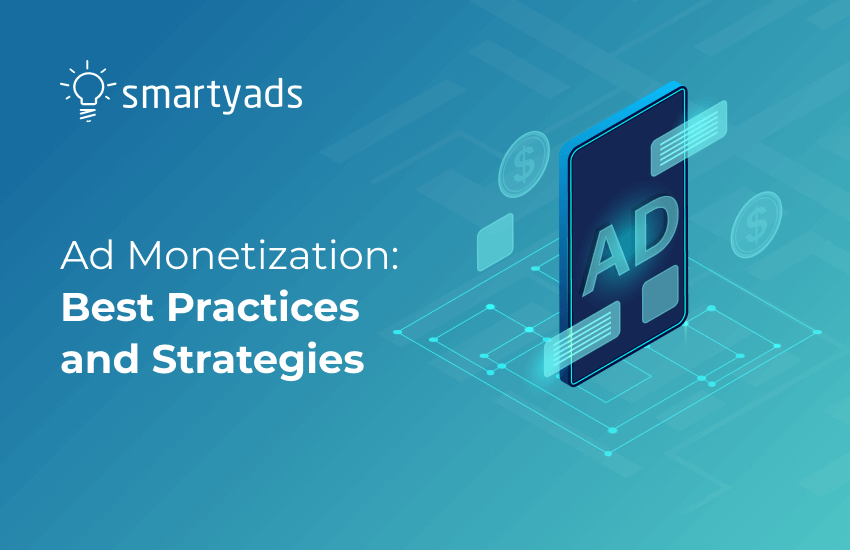


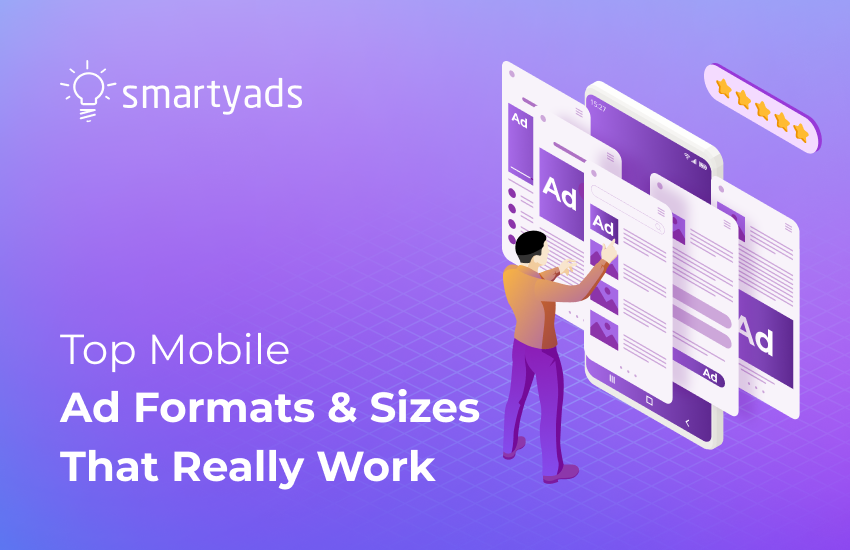
![In-App Advertising: the Complete Guide [Updated 2025]](/storage/uploads/2020/september/in-app-advertising-trends.png)